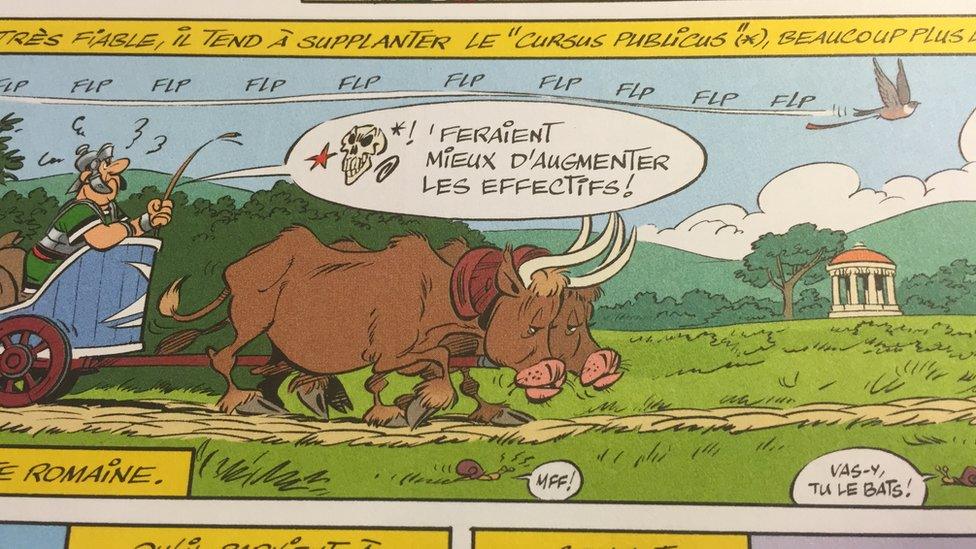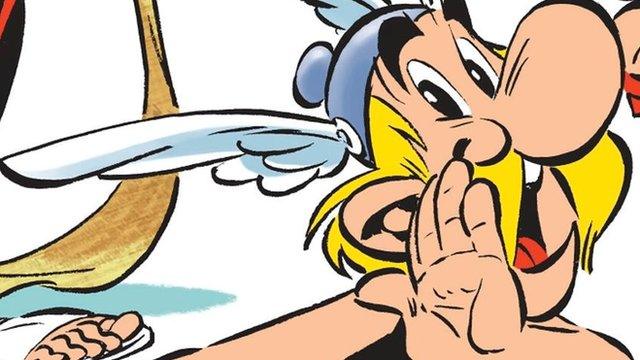Asterix is back and takes Rome into info age
- Published

Asterix and the Missing Scroll (Le Papyrus de César in French) is edition 36 from the Asterix series
The new Asterix book, published on Thursday in France and several other countries, marks a tremendous return to form after a series of embarrassing efforts.
Original artist Albert Uderzo had tried working solo, and then a new a team of Ferri and Conrad had a workmanlike but uninspiring first go with Asterix and the Picts.
Now the duo have us laughing once again with Asterix and the Missing Scroll (Le Papyrus de Cesar in French).

(From L) French cartoonist and author Albert Uderzo with artist Didier Conrad and scriptwriter Jean-Yves Ferri
The storyline is worthy of the master Rene Goscinny, who died in 1977. It starts with Caesar in Rome completing his famous book, The Gallic Wars.
After initially including a chapter admitting his failure to take a certain impregnable village in northern Brittany, he is persuaded to excise it by communications adviser Promoplus, a lookalike of well-known French PR-man Jacques Seguela.
Better for his image, you see.
However a Numidian slave-scribe - acting in solidarity with the oppressed people of Gaul - smuggles out a copy of the missing chapter, which then falls into the hands of Doublepolemix, a jobbing hack and tireless campaigner for open information.
This is the character - as numerous leaks have already told us - based on Julian Assange, complete with blonde hair and stubble.
"I have on me a document which is going to make the Empire tremble," he tells a bemused Obelix after he makes his way to the village. "The missing papyrus of Caesar's book!"
It is a brilliant conceit and, as Promoplus desperately sets out to recover the papyrus, the album riffs with constant amusement on the themes of news and communications.
The new technology is the carrier pigeon, supplanting the old ox-and-cart postal system. As a pigeon races past a grumpy Roman post-officer, he mutters in true Luddite fashion: "They'd be better off investing in more staff."

The album riffs with constant amusement on the themes of news and communications
The Gauls' device for saving the chapter is to take it to the oldest druid of them all, who lives in an immense forest, and there have it recited to him so he can memorise it.
This is a wonderful play on the idea of digitising information. Once it is in the super-brain (read computer), no effort at censorship will ever succeed.
And so it happens that the adventures - about Corsica, Egypt, the English, the Swiss etc etc - are passed on from generation to generation until they come to the ears of a 20th-Century pair of Paris miscreants: Goscinny and Uderzo!
Artist Didier Conrad and scriptwriter Jean-Yves Ferri have come very close to re-capturing the spirit of the early Asterix books.
All the usual running gags are there, of pirates, fish-fights and so on, plus plentiful word-play which will have proved quite a challenge for veteran English translator Anthea Bell.
The Asterix PR machine is used to ramping up the superlatives. For the first time in years, they may be deserved.
- Published14 October 2015

- Published27 September 2011
